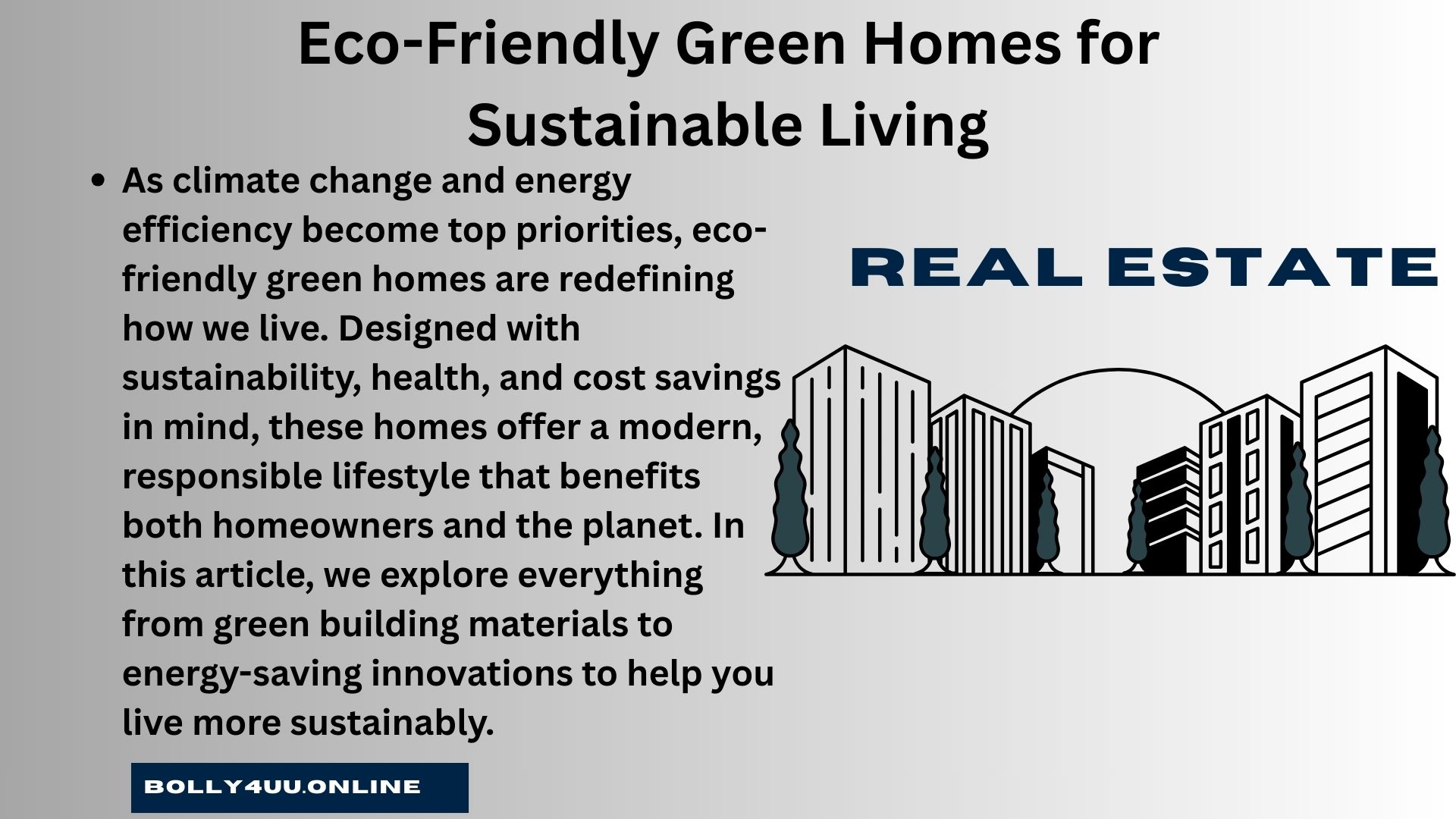Introduction
As climate change and energy efficiency become top priorities, eco-friendly green homes are redefining how we live. Designed with sustainability, health, and cost savings in mind, these homes offer a modern, responsible lifestyle that benefits both homeowners and the planet. In this article, we explore everything from green building materials to energy-saving innovations to help you live more sustainably.
1. What Is an Eco-Friendly Green Home?
An eco-friendly green home is a residential building designed and built to minimize environmental impact. These homes prioritize:
- Energy efficiency
- Water conservation
- Non-toxic materials
- Sustainable construction practices
- Integration with nature
The goal is to reduce carbon footprint, lower utility costs, and create healthier living environments.
2. Key Features of Sustainable Homes
The most effective green homes often include the following:
- Solar panels for renewable energy
- Energy-efficient insulation and windows
- LED lighting and smart thermostats
- Low-VOC paints and finishes
- Water-saving fixtures (e.g., low-flow toilets, rainwater harvesting systems)
- Sustainable landscaping using native plants
These features work together to conserve resources and enhance indoor comfort.
3. Benefits of Green Homes
Investing in a green home comes with numerous benefits:
- ✅ Lower energy bills
- ✅ Healthier indoor air quality
- ✅ Increased home value and marketability
- ✅ Government incentives and tax rebates
- ✅ Environmental stewardship
It’s a win-win: you save money and contribute to a healthier planet.
4. Green Building Certifications to Know
When buying or building a green home, look for trusted certifications such as:
- LEED (Leadership in Energy and Environmental Design)
- ENERGY STAR®
- National Green Building Standard (NGBS)
- WELL Building Standard (health and wellness focus)
- Passive House Certification
These certifications validate the home’s sustainability and quality standards.
5. Top Eco-Friendly Building Materials
Sustainable homes use materials that are renewable, recycled, or low-impact, such as:
- Bamboo or reclaimed wood flooring
- Recycled steel and concrete
- Cork insulation
- Natural clay or lime plaster
- Recycled glass countertops
These materials are durable, beautiful, and environmentally responsible.
6. Smart Tech for Sustainable Living
Modern green homes are powered by smart technology that improves energy use:
- Smart thermostats (e.g., Nest, Ecobee)
- Energy monitoring systems
- Smart irrigation systems
- Automated lighting and window shades
- Battery storage for solar systems
Tech-enabled homes not only reduce waste but also add convenience and control.
7. Best Cities for Green Living in 2025
Certain U.S. cities lead the way in sustainability and green housing:
- 🌿 Portland, OR – Eco-conscious policies and green architecture
- 🌿 Boulder, CO – LEED-certified communities and walkable design
- 🌿 Austin, TX – Solar incentives and smart growth initiatives
- 🌿 Minneapolis, MN – Sustainable transit and green buildings
- 🌿 San Francisco, CA – Strong regulations and energy efficiency programs
These locations provide eco-friendly infrastructure, incentives, and lifestyle options.
8. Costs & Financial Incentives
While green homes may have higher upfront costs, they offer long-term savings.
Plus, you may qualify for:
- Federal solar tax credits (Investment Tax Credit, ITC)
- State rebates for energy-efficient upgrades
- Green mortgage programs
- Property tax incentives
Always check with local and federal programs to take advantage of current offers.
9. Tips for Buying or Building a Green Home
Before you invest in a green home:
- ✅ Verify certifications (LEED, ENERGY STAR, etc.)
- ✅ Evaluate location for solar or passive design potential
- ✅ Choose builders with sustainability credentials
- ✅ Consider lifecycle costs, not just upfront price
- ✅ Ask about insulation, water systems, and indoor air quality
Due diligence ensures you get true eco-value, not just marketing buzzwords.
10. Living Sustainably After You Move In
Sustainable living doesn’t stop after you buy the house. Try these habits:
- 💡 Turn off lights and unplug devices when not in use
- 💧 Use cold water for laundry and install aerators
- ♻️ Compost and recycle regularly
- 🌱 Grow your own herbs or vegetables
- 🚴♂️ Bike or walk instead of driving when possible
Small changes add up to a more sustainable lifestyle.
Conclusion
Eco-friendly green homes are the future of responsible living. Whether you’re a first-time buyer, investor, or homeowner looking to renovate, embracing green design and technology leads to lasting value—for your finances, your health, and the planet.
Suggested CTA (Call to Action)
Ready to go green? Explore our listings of eco-certified homes or contact a sustainability-focused real estate agent to learn more.
This article is optimized for search terms like:
- “Eco-friendly homes for sale”
- “Sustainable houses 2025”
- “Green building features”
- “Living in an environmentally friendly home”
